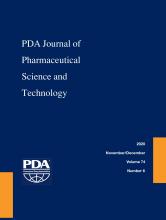Abstract
The pharmaceutical industry is currently being confronted with new and complex challenges regarding the aseptic filling of parenterals, especially monoclonal antibodies, particularly for fill volumes <200 µL, which have become increasingly important with the increasing and continued development of intravitreal drugs and highly concentrated formulations. Not only does low-volume filling pose challenges to aseptic manufacturing, but the development of suitable in-process control to ensure reliable and robust filling processes for low-volume conditions has also been difficult. In particular, fill volumes <200 µL exceed limits of accuracy and robustness for the well-established method of gravimetric fill-volume control. Therefore, the present study aimed to evaluate and test novel sensors, which may allow the accurate and precise 100% contact-free measurement of drug-product formulations, with respect to filling volumes. These sensors were designed to be less influenced by inevitable noise factors, such as unidirectional airflow and vibrations. We designed the study using five different sensor concepts, to screen and identify suitable alternatives to gravimetric fill-volume control. The examined sensor concepts were based on airflow, capacitive pressure, light obscuration. and capacitive measurements. Our results demonstrated that all of the tested sensor types worked in the desired low-volume range of 10–150 µL and showed remarkable results, in terms of accuracy and precision, when compared with a high-precision gravimetric balance. A sensor based on capacitance measurement was identified as the most promising candidate for future sensor implementation into an aseptic filling line. This sensor design proved to be superior in terms of both sensitivity and precision compared with the other tested sensors. We concluded that this technology may allow the pharmaceutical industry to overcome existing challenges with respect to the reliable measurement of aseptic fill volumes <200 µL. This technology has the potential to fundamentally change how the pharmaceutical industry verifies fill volumes by facilitating 100% in-process control, even at high machine speeds.
- © PDA, Inc. 2020
PDA members receive access to all articles published in the current year and previous volume year. Institutional subscribers received access to all content. Log in below to receive access to this article if you are either of these.
If you are neither or you are a PDA member trying to access an article outside of your membership license, then you must purchase access to this article (below). If you do not have a username or password for JPST, you will be required to create an account prior to purchasing.
Full issue PDFs are for PDA members only.
Note to pda.org users
The PDA and PDA bookstore websites (www.pda.org and www.pda.org/bookstore) are separate websites from the PDA JPST website. When you first join PDA, your initial UserID and Password are sent to HighWirePress to create your PDA JPST account. Subsequent UserrID and Password changes required at the PDA websites will not pass on to PDA JPST and vice versa. If you forget your PDA JPST UserID and/or Password, you can request help to retrieve UserID and reset Password below.






